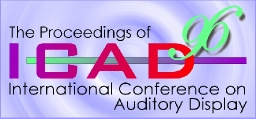

|
Introduction: Retrospective |

|
In 1980, while I was working in a physics group at Exxon Research and Engineering Company, a newly-hired cognitive psychologist named Joe Mezrich approached me about building a lab to investigate novel visual data representation techniques (to the best of my knowledge, the term "visualization" had not yet been coined). I agreed to help, but for reasons which are still unclear, beyond my prior adventures in electronic music, I inquired as to whether we shouldn’t also consider auditory data representation. As a result, when we built our laboratory we included a DMX-1000 digital signal processor/synthesizer, purchased from Dean Wallraff of Digital Music Systems, and began to experiment with dynamic auditory/visual displays for multivariate time-series data. I learned many things from this work, including the value, and even the necessity, of a rigorous experimental approach to the human/computer interface. Our results have been amply described elsewhere, but it suffices to say that we achieved and exceeded Exxon’s objectives, and proved that, at least under some circumstances, sound is an effective display medium for exploratory data analysis.
At that time, we were aware of very few examples of this sort of work in the literature, essentially one or two papers per decade from the 1940s through the 1970s. But then Dean Wallraff mentioned a doctoral student named Sara Bly, at Lawrence Livermore National Laboratory, who was also engaged in auditory display research, and who had talked to him about his DMX-1000 product. Through contacting Sara, we discovered a kindred spirit—one who had demonstrated the value of auditory displays, but was mystified about the absence of this work in the literature. Shortly thereafter, we found and added Dave Lunney of East Carolina University to our small circle of friends, and proceeded to exchange ideas and share conference podia over the next several years. We often talked about the need to somehow organize the body of work which I refer to as Auditory Data Representation (ADR), and to develop an outlet for the results of workers in what we perceived to be a field long overdue. However, we were unsuccessful in this regard, and concluded that the poor reception the computer world gave ADR was in large part due to the difficulty and expense of providing sound hardware and software in the platforms then available to decision makers who might have made use of it. Each of us began giving more attention to other aspects of our portfolios, and the field seemed to languish. In the last half of the 1980s, the Musical Instrument Digital Interface (MIDI) made computer control of sound synthesis orders of magnitude easier than it had been, and shortly after that the personal computer world received sound generation and synthesis hardware as part of a multimedia package, largely to permit high-quality playback of sounds stored on the new CD ROMs. Suddenly, ordinary folks had more sound synthesis capability on their desks than they knew how to use. Around 1990, long after I had left Exxon Research for Bell Labs, I received a call from Greg Kramer, who wanted to pull the auditory display world together and get it moving again. I told him that we’d been there and tried that, and that it was difficult, but he was not easily dissuaded. He proposed the organization of a conference, now known as ICAD’92, about which we spoke many times during the next year or so. One of my permanent professional regrets is that I was unable to attend that conference, for it proved to be a watershed. The number of self-identified ICAD workers has steadily increased, albeit along with a broadening of the scope, and ICAD’94 saw more than a hundred participants, many from outside of the U.S., sharing ideas about auditory display. Now we meet for our third conference, as well as to attend the birth of a new non-profit corporation intended to further the objectives of ICAD. This is a remarkable time, and, as you can tell from the above, a very nostalgic one for me. While I missed auditory display’s baby steps in the '40s and '50s, I was privileged to attend its exciting and uncertain adolescence in the '80s, with all that such a period entails. I think I can safely say that it is now coming of age, and will leave its mark on the world as a unique, fascinating, and grown-up field. |